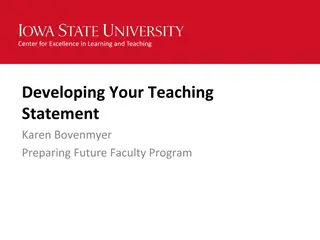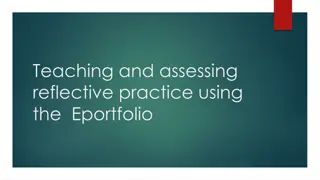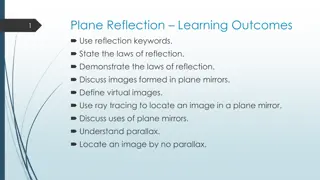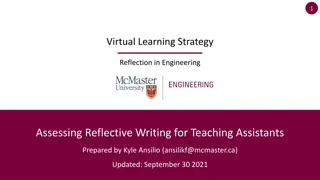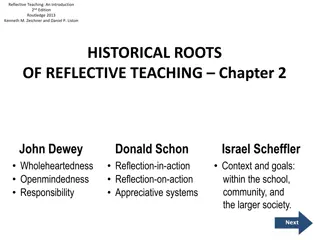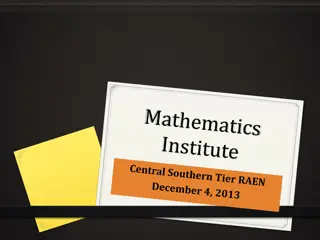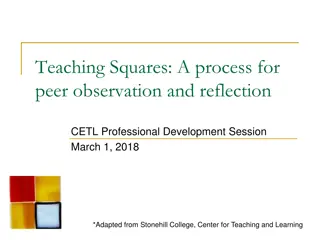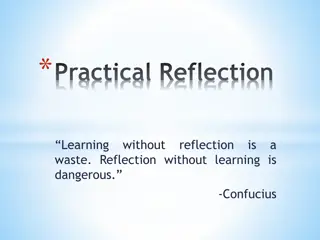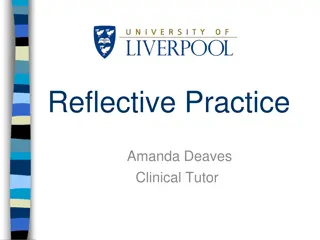Reflection on Varied Teaching Strategies by Different Groups
Three different groups reflect on their teaching roles and strategies regarding giving clear instructions, creating visually stimulating tasks, building routines, and extending textbook activities. They explore dialectical and contextual modes to enhance their teaching effectiveness, adapt instructions to different learner levels, utilize various resources and techniques, and consider student backgrounds and interests for improved engagement and language learning outcomes.
Download Presentation

Please find below an Image/Link to download the presentation.
The content on the website is provided AS IS for your information and personal use only. It may not be sold, licensed, or shared on other websites without obtaining consent from the author. Download presentation by click this link. If you encounter any issues during the download, it is possible that the publisher has removed the file from their server.
E N D
Presentation Transcript
FINAL REFLECTION: GROUP YELLOW Directions: Roles: Choose one topic below Brainstorm contextual & dialectical modes Summarize each mode in the boxes below Use emojis in chat to show your reaction Note taker: Woomee Timekeeper: Umida Chat Monitor: Nargiza Encourager: G ayrat Choice #1: Giving Clear Instructions Choice #2: Creating Visually Stimulating Tasks Dialectical Mode: I analyzed my instructions given during the lesson and identified successful ones and weaker ones. I will try to change my weaker instructions by slowing down my speaking pace maybe. Dialectical Mode: Contextual Mode: Differentiate instructions, different background knowledge, break down instructions into steps depending on the learners (young learners) but for older learners we do differently to meet their levels Contextual Mode: Technical Mode: I learned: Break down instructions step by step, check students' understanding throughout the lesson/activity Pause when giving instructions Technical Mode: I learned visual tools can be used to activate prior knowledge, support language production, integrate cultural realia, and assess comprehension. Examples are graphic organizers, word walls, and activities (See, Think, Wonder; Zoom out photos).
FINAL REFLECTION: GROUP RED Directions: Roles: Choose one topic below Brainstorm contextual & dialectical modes Summarize each mode in the boxes below Use emojis in chat to show your reaction Note taker: Kelley Timekeeper: Jonhojir Chat Monitor: Dilbar Encourager: ALL of us! Choice #1: Building Routines Choice #2: Extending Textbook Activities Dialectical Mode: Dialectical Mode: I consider my students prior knowledge and cultures when using activities, using engaging topics of their interests so they will want to speak in the target language. Sometimes the texts are at a higher level, so I use additional resources and games that are at my students level.so they can all participate. Contextual Mode: Contextual Mode: When I have big class sizes, it is beneficial to organize small groups for students to share. I adapt my textbook activities to extend questions, use jigsaw activities to help break down large text, add short videos to explain new content, using realia (objects) to help students learn vocabulary more easily. Technical Mode: I learned: Benefits of routines (e.g., less stress/anxiety, build confidence) Examples of classroom routines to increase English use (e.g., greetings, warm-ups, wrap-up activities, daily mingle) Technical Mode: I learned ways to adapt textbook activities to be engaging and interactive (e.g., Jig saw, learner preferences, culturally appropriate) and considerations when adapting textbook activities (e.g., class size, language level, age, prior knowledge).
FINAL REFLECTION: GROup BLUE Directions: Roles: Choose one topic below Brainstorm contextual & dialectical modes Summarize each mode in the boxes below Use emojis in chat to show your reaction Note taker: Becky Timekeeper: Zebo Chat Monitor: Ataboyeva Encourager: Meyrbek Choice #1: Facilitating Discussions & Debates Choice #2: Checking Comprehension Dialectical Mode: I can check for comprehension using approaches like five finger check to get the feedback to make changes in my classes. Checklists can tell me what students learned, and based on the results the teacher can adjust the next lesson. I can use exit tickets; eye contact can also help me adjust in action. This can help me change what I do. Dialectical Mode: Contextual Mode: I can connect to my experience and to our module content -- I want to use indirect strategies because I can check comprehension through question/answer because there is less anxiety for the learner. I can compare my own experience to the module readings. Ex., thumbs up/down helped my students gain more learning and confidence. Contextual Mode: Technical Mode: I learned to consider purposeful grouping of students, setting discussion norms, maximizing participation, and working with my classroom space. I need to scaffold how to respond with Sentence starters/frames, or Anchor Charts. Technical Mode: I learned feedback strategies to foster communicative language development (e.g., whole class, beyond error-correction, anxiety-free) and to avoid correcting mistakes of individual students. Formative feedback. Summative feedback.
FINAL REFLECTION: GROUP GREEN Directions: Roles: Choose one topic below Brainstorm contextual & dialectical modes Summarize each mode in the boxes below Use emojis in chat to show your reaction Note taker: Joan Timekeeper: Albina Chat Monitor: Lola Encourager: Makjliyo Choice #1: Effective Q & A Choice #2: Managing Cooperative Activities Dialectical Mode: Dialectical Mode: Before organizing cooperative projects, we have to reflect on our teaching. We have to take into consideration our specific learners before implementing any new practices. We should ask ourselves What should I do to make this more interesting for my students? What challenges might I have to do cooperative projects? What strategies should I use for better classroom management? We can make cooperative projects a daily classroom routine. We can improve managing them the more we use them. Contextual Mode: Contextual Mode: In the TESOL course, we were given a chance to choose our peers, and we experienced learning from each other. We should give them opportunity to choose their partners and encourage them to be more autonomous. Monitor students as they are cooperating independently to give them guidance to be successful. They take responsibility for themselves. Students can also be more autonomous in learning stations. This also help differentiated instruction with learners at different levels contributing. Technical Mode: I learned teacher talk examples to promote meaningful and effective engagement during listening activities (e.g., predicting, understanding main ideas, making inferences, asking opinions) and the importance of wait time. Technical Mode: I learned the purpose of cooperative work is to engage students with each other as they interact in the target language and achieve a mutual goal through completing a task. Having checklists, assigned roles, purposeful partners is important.
FINAL REFLECTION: GROUP PURPLE Directions: Roles: Choose one topic below Brainstorm contextual & dialectical modes Summarize each mode in the boxes below Use emojis in chat to show your reaction Note taker: Jered Timekeeper: Gulirano Chat Monitor: Dilnoz Encourager: all of us Increasing Classroom Interactions Dialectical Mode (Now what?): We will start with simple opportunities so that they can practice the process. We will survey students at the start of year to better understand their learning preferences, background, and interests. Ensure that students have the vocabulary they need. Focus on the needs of our students. Providing them with more scaffolding activities and allow for more social interactionsso that they are comfortable with each other. We can also include student helpers. Contextual Mode (So What?): Maintaining the use of English even when students are working together. Encouraging shy students to be more interactive. Important to select/create activities that are appropriate and interesting. It can also be challenging to keep students on task. It is important for the teacher to introduce the activity correctly. Providing opportunities for all students to participate. Noise level can get pretty high. We can use ice-cream sticks. The need to make the activities more student-centered. Technical Mode (What?): I learned about the importance of creating a sense of community in your classroom (e.g., Getting to Know You activities to increase classroom interaction) & giving opportunities for student interactions (e.g., Turn-and-Talk, Think-Pair-Share, Find someone bingo). Connecting to student interests. Interactive activities helps to reduce student anxiety and believe in themselves by making passive students more active.
FINAL REFLECTION: GROUP GRAY Directions: Roles: Choose one topic below Brainstorm contextual & dialectical modes Summarize each mode in the boxes below Use emojis in chat to show your reaction Note taker: Hyunsun Timekeeper: Yayra Chat Monitor:Umida Encourager: Khurshida Choice #1: Facilitating Discussions & Debates Choice #2: Building Routines Dialectical Mode: age, level, ability of SS will be my consideration in discussion/debate classroom (i have different culture, languages, I want to be sensitive about topic as well), I will consider Ss interest//elicit answers from students//the topic vocabulary must be appropriate and familiar to learners Dialectical Mode: Contextual Mode: Facilitating discussion freely (that is a teacher s role) helping them to learn autonomy and confidence Building relationship is important, teaching respect, and relationship is needed. Discussions and debates make students to think critically Scaffolding debates with organizers and functional words is important because they will give learner opportunity to debate in a proper way Technical Mode: I learned to consider purposeful grouping of students, setting discussion norms, maximizing participation, and working with my classroom space. I need to scaffold how to respond with Sentence starters/frames, or Anchor Charts. Contextual Mode: Technical Mode: I learned: Benefits of routines (e.g., less stress/anxiety, build confidence) Examples of classroom routines to increase English use (e.g., greetings, warm-ups, wrap-up activities, daily mingle)
FINAL REFLECTION: GROUP PINK Directions: Roles: Choose one topic below Brainstorm contextual & dialectical modes Summarize each mode in the boxes below Use emojis in chat to show your reaction Note taker: Dildora Timekeeper: Gulnura Chat Monitor: Umedjon Encourager: Oleg Choice #1: Increasing Classroom Interactions Choice #2: Extending Textbook Activities Dialectical Mode: We learned that we should be aware of choosing topics. Accept circumstances, skills sets, learn new skills to make positive changes and analyze problems, encourage students to exchange/ express opinions. Scaffold students to interact. Dialectical Mode: Contextual Mode: I learned that I have to keep in mind cultural peculiarities of our students. Relevant material to the age and level of the students. They like different celebrities, for example who am I. To give a chance to choose. Knowledge and experience. Contextual Mode: Technical Mode: I learned about the importance of creating a sense of community in your classroom (e.g., Getting to Know You activities to increase classroom interaction) & giving opportunities for student interactions (e.g., Turn-and-Talk, Think-Pair-Share). Technical Mode: I learned ways to adapt textbook activities to be engaging and interactive (e.g., Jig saw, learner preferences, culturally appropriate) and considerations when adapting textbook activities (e.g., class size, language level, age, prior knowledge).
FINAL REFLECTION: GROUP ACQUA Directions: Roles: Choose one topic below Brainstorm contextual & dialectical modes Summarize each mode in the boxes below Use emojis in chat to show your reaction Note taker: Anya Timekeeper: Lora Chat Monitor: Kodirova Encourager: Madina Choice #1: Managing Cooperative Activities Choice #2: Effective Question & Answer Dialectical Mode: Dialectical Mode: questions before listening task helped them to comprehend during listening task; note students mistakes, so I can make plans for future teaching; it will improve students confidence Contextual Mode: Contextual Mode: after reviewing the module materials I found specific ideas about how to use questions before reading and writing, provide background knowledge; use wh-questions for critical thinking; ask specific questions to monitor comprehension Technical Mode: I learned the purpose of cooperative work is to engage students with each other as they interact in the target language and achieve a mutual goal through completing a task. Having checklists, assigned roles, purposeful partners is important. Technical Mode: I learned teacher talk examples to promote meaningful and effective engagement during listening activities (e.g., predicting, understanding main ideas, making inferences, asking opinions) and the importance of wait time.





